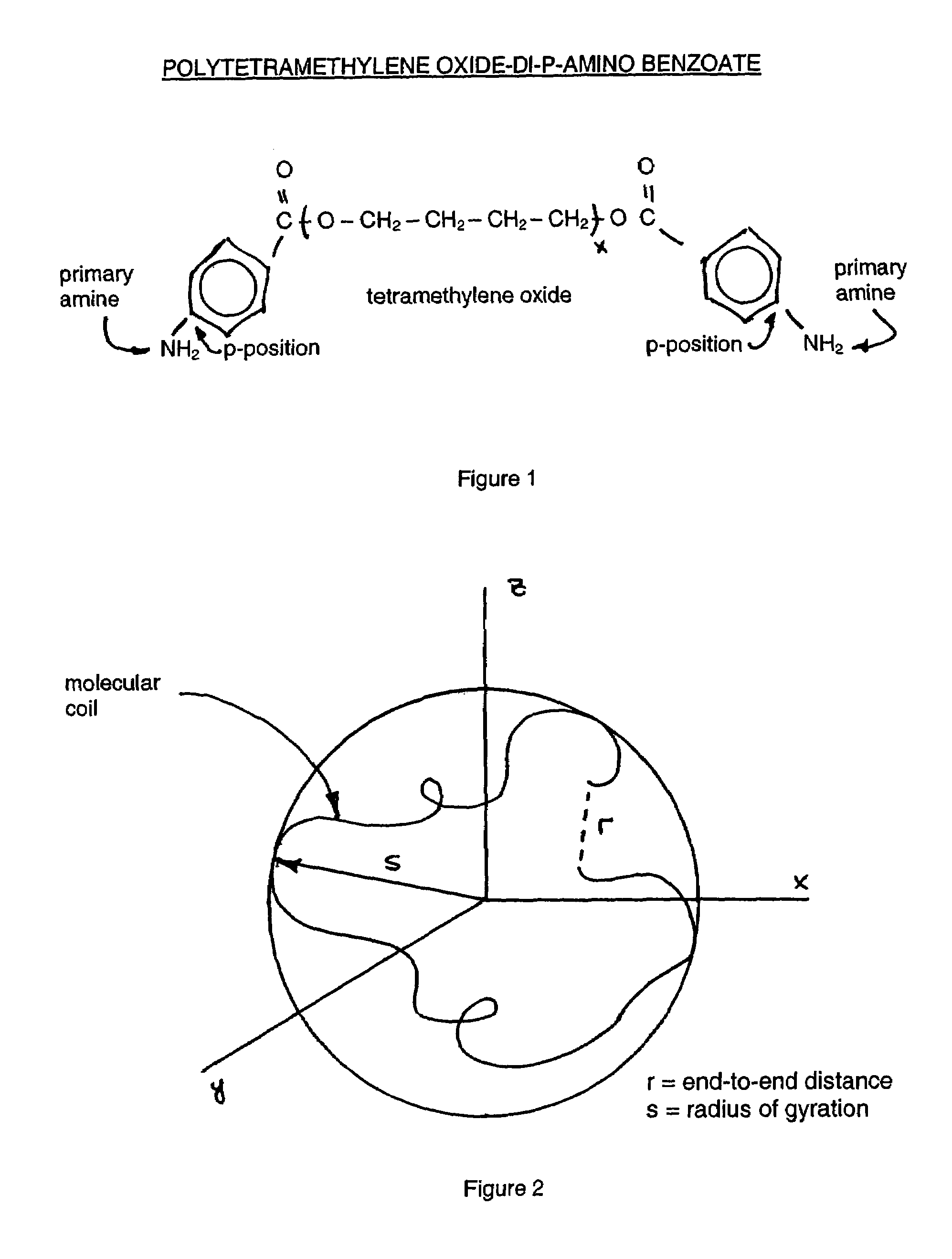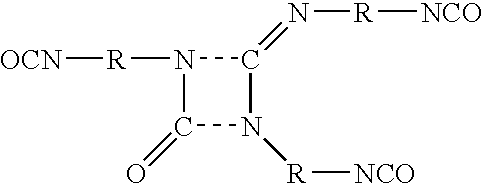Non-toxic hydrophobic elastomeric polymer chemistry system for wood preservation
- Summary
- Abstract
- Description
- Claims
- Application Information
AI Technical Summary
Benefits of technology
Problems solved by technology
Method used
Image
Examples
example # 1
Example #1
Formulation #1
[0163]Liquid thermosetting, hydrophobic, elastomeric, non-toxic polyurethane / urea polymer solution was prepared as generally described in Example No. 1, using the following reactants:
[0164]
StoichiometricReagentVolumeVolume Ratio1) Acetone 116 ml.0.8102) Primary diamine 12 ml.0.084 D-20003) Secondary diamine 3.0 ml.0.02T UOP 42004) Poly (oxyalkylene) 6.0 ml.0.042 polyol Multranol 40125) Diphenylmethane 6.2 ml.0.043 diisocyanate Rubinate 9433143.20 ml.Tot. Vol.1.000
Solution was stirred in same manner as Example No. 1.
Procedure
[0165]1) Solution was stir-blended constantly at 20 paddle revolutions per minute during the sequential addition of the ingredients, and for 15–20 minutes after addition of last ingredient, namely the diisocyanate. The parameters of the stir-blending process, in terms of revolutions and time, are the most optimum for obtaining maximum sequential reactivity of the ingredients during blending.
[0166]2) Standard wooden tongue depressors...
example # 2
Example #2
Formulation #2
[0171]Liquid thermosetting, hydrophobic, elastomeric, non-toxic polyureathane / urea polymer solution was prepared as generally described in Example No. 1, using the following reactants:
[0172]
StoichiometricReagentVolumeVolume Ratio1) Acetone 116 ml.0.8102) Primary diamine 12 ml.0.084 D-20003) Secondary diamine 3.0 ml.0.02T UOP 42004) Poly (oxyalkylene) polyol 6.0 ml.0.042 Multranol 40125) Diphenylmethane 6.2 ml.0.043 diisocyanate Rubinate 9433143.20 ml.Tot. Vol.1.000
Solution was stirred in same manner as Example No. 1.
[0173]Results:[0174]1) approximately a 20% viscosity increase, with respect to Example No. 1[0175]2) test stick—dip tack free dry time: 4–5 minutes[0176]3) water absorption—three hours after impregnation: less than 0.005%
[0177]Primary intended use: Moderate viscosity liquid for enabling complete impregnation preservation of porous grain woods, e.g., Southern yellow pine, oak, poplar, birch.
example # 3
Example #3
Formulation #3
[0178]The preparation procedure of Example No. 1 was repeated under the following conditions:
[0179]
StoichiometricReagentVolumeVolume Ratio1) Acetone 150 mls0.6642) Mineral spirits 60 mls0.2653) Primary diamine10.80 mls0.048 D-20004) Secondary diamine 2.0 mls0.009 UOP 42005) Diphenylmethane 3.2 mls0.014 diisocyanate Rubinate 9433226.0 mlstotal1.000
[0180]Results:[0181]a) Tack-free dry-time—15–20 minutes[0182]b) Water absorption—exposure one hour, less than 0.01%
[0183]Primary intended use: Low viscosity, high penetration liquid polymer solution for application as a hydrophobic surface sealant on old CCA-treated wood for the prevention of toxic leaching when surface exposed to environmental water conditions, e.g., rain, snow, or excessive humidity.
[0184]The polymer chemistry-based formulations of the present invention for use as wood preservatives and preservation exhibit many desirable properties and characteristics. They are non-toxic; non-human carcinoge...
PUM
| Property | Measurement | Unit |
|---|---|---|
| Fraction | aaaaa | aaaaa |
| Fraction | aaaaa | aaaaa |
| Fraction | aaaaa | aaaaa |
Abstract
Description
Claims
Application Information
 Login to View More
Login to View More - R&D Engineer
- R&D Manager
- IP Professional
- Industry Leading Data Capabilities
- Powerful AI technology
- Patent DNA Extraction
Browse by: Latest US Patents, China's latest patents, Technical Efficacy Thesaurus, Application Domain, Technology Topic, Popular Technical Reports.
© 2024 PatSnap. All rights reserved.Legal|Privacy policy|Modern Slavery Act Transparency Statement|Sitemap|About US| Contact US: help@patsnap.com










